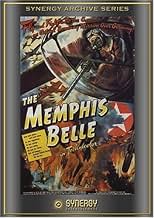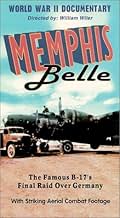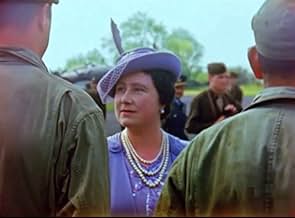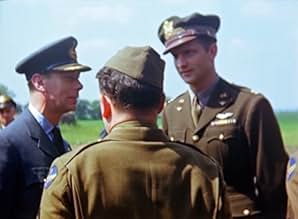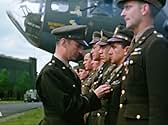Le Memphis Belle, histoire d'une forteresse volante
Original title: The Memphis Belle: A Story of a Flying Fortress
IMDb RATING
7.4/10
2K
YOUR RATING
A documentary on the 25th bombing mission of the Memphis Belle, a B-17 in the US 8th Air Force.A documentary on the 25th bombing mission of the Memphis Belle, a B-17 in the US 8th Air Force.A documentary on the 25th bombing mission of the Memphis Belle, a B-17 in the US 8th Air Force.
- Director
- Writers
- Stars
- Awards
- 4 wins total
Stanley Wray
- Self - Group Commander
- (as Col. Stanley Wray)
Robert Morgan
- Self - Pilot
- (as Capt. Robert Morgan)
James A. Verinis
- Self - Co-Pilot
- (as Capt. Jim Verinis)
Robert J. Hanson
- Self - Radio Operator
- (as Sgt. Bob Hanson)
Charles B. Leighton
- Self - Navigator
- (as Capt. Chuck Leighton)
Harold P. Loch
- Self - Engineer and Top Turret Gunner
- (as Sgt. Harold Loch)
John P. Quinlan
- Self - Tail Gunner
- (as Sgt. John Quinlan)
Cecil H. Scott
- Self - Turret Gunner
- (as Sgt. Cecil Scott)
Vince Evans
- Self - Bombardier
- (as Captain Vincent Evans)
Clarence E. Winchell
- Self - Waist Gunner
- (as Sergeant Bill Winchell)
Casimer A. Nastal
- Self - Waist Gunner
- (as Sergeant Tony Nastal)
Haywood Hansell
- Self - USAAF
- (as Brigadier General Hansell)
Ira C. Eaker
- Self - Commander: 8th Air Force
- (as General Eaker)
Jacob L. Devers
- Self - U.S. Commander: European Theatre
- (as General Devers)
- Director
- Writers
- All cast & crew
- Production, box office & more at IMDbPro
Featured reviews
This is a documentary made by the US Army Air Corps and directed by William Wyler during WWII and. It features the plane and crew of the Memphis Belle—the first bomber to complete its tour of duty successfully. Because of its successes and luck, the bomber and crew were eventually returned to the US for a bond-raising tour. This film was made to coincide with this.
A few things will probably strike you as you watch. First, it is (unlike most films of the day) in color—albeit a bit grainy and washed out. Second, the narration is very grim and direct—non-romanticized all the way. As for the film itself, it's a delight to air buffs as it not only shows footage of the bomber but shows it in action, explains bombing runs and other technical information. It even shows footage of bombers being shot down and damage to the bombers. Clearly this is not just another gung-ho propaganda film but one that stresses realism above all. As a result of these factors, this is a great film—one that is gripping even when seen today.
A few things will probably strike you as you watch. First, it is (unlike most films of the day) in color—albeit a bit grainy and washed out. Second, the narration is very grim and direct—non-romanticized all the way. As for the film itself, it's a delight to air buffs as it not only shows footage of the bomber but shows it in action, explains bombing runs and other technical information. It even shows footage of bombers being shot down and damage to the bombers. Clearly this is not just another gung-ho propaganda film but one that stresses realism above all. As a result of these factors, this is a great film—one that is gripping even when seen today.
The pilot was 24-year-old Captain Robert K. Morgan from Asheville, North Carolina who was an industrial engineer before joining the Army in 1941; the co-pilot, whom Captain Morgan insisted was "the other pilot', was 25-year-old Captain James A. Verinis from New Haven, Connecticut, who was a business administration student at the University of Connecticut before entering the service in July of 1941; Captain Vincent B. Evans, the 23-year-old bombadier was one of the two married members of the crew, and was a fleet-truck operator in his home town of Fort Worth, Texas before enlisting in January of 1942; Captain Charles B. Leighton, from East Lansing,Michigan and a chemistry student at Ohio Wesleyan before entering the service, was the navigator. The engineer and top turret gunner was Technical Sergeant Harold P.Loch, a 23-year-old stevedore from Green Bay, Wisconsin who joined the service in November of 1941; Technical Sergeant Robert J.Hanson, a construction worker from Washington state and the other married crew member, was the radio operator. The 19-year-old "baby" of the Memphis Belle crew was waist-gunner Staff Sergeant Casimer A. Nastal who was a washing machine repairman from Detroit, Michigan with two confirmed fighter kills to his credit who thought he had more "but never had time to watch whether they went down"; Staff Sergeant Cecil H. Scott, a pressman for a rubber company in Rahway, New Jersey was the ball turret gunner and, at 27, the oldest member of the crew. One of the three cameraman was First Lieutenant Harold J. Tannenbaum, from Binghamton,New York, a World War I veteran who remained in the Navy until 1927. He re-entered the service in July,1942 when he received his commission in the Army Air Force. He was killed in action,age 46,in April of 1944 and received a posthumous Purple Heart.
"A Story Of A Flying Fortress"
The Boeing B-17 is a modern era legend and one of the most successful weapons of war to ever fly.
This documentary served to tell a story about the men who flew the Belle, as well as other air crews who flew other B-17s in the 91st bomb group along with other bomb groups in the 8th Air Force, all of whom helped win the war in Europe.
The film did not, however, mention the affection that these men often held for their airplane, cleaving unto it like a lover and depending on it to protect them and bring them home safely. Their lives depended upon their airplane's performance, durability, and function. They would regard their particular personal airplane like they regarded a first car, their "hot rod". This is why almost every B-17 received a personal moniker via nose-art, a name, and it was usually female in gender... such as "The Memphis Belle".
"That's my girl over there!"
These airplanes certainly had an identity, a presence, and in a manner of speaking, a soul... and air crews who saw other B-17s around them fatally damaged, going down often in flames, would watch in horror as the B-17 died. They knew a kinship with those other airplanes and the men in them. They would fight viciously at their gun positions to defend their girl from the enemy fighter planes which would kill her and them, if they could. The air war over Germany was a bloody and violent sort of thing, with hundreds of thousands of casualties suffered in the air before war's end.
Some years ago, when the Memphis Belle was in process of undergoing a restoration in Tennessee (much of what was initially done by Memphis Aerotech) I chased down the man who was heading up the restoration efforts to ask if I could have access to the airplane and photograph it, explaining that I was a photographer as well as a war-bird buff, and I was given access to where the airplane was parked, leaving me alone with the world's most famous B-17.
After shooting a hundred or so photographs, I went forward and sat in the cockpit, in the pilot's seat, staring out through the Plexiglas, thinking about WW-II and the missions this airplane flew, remembering that I was sitting in the ONLY surviving B-17 'F' model that saw combat.
THIS was the very same airplane that I'd watched countless times, while viewing Wyler's documentary film that had inspired me so much...
It's no wonder that the Belle is the only surviving 'F' combat model B-17 because so very few of the 'F' models came back, flying earlier in the war when the Luftwaffe was still powerful, tearing up formations of bombers in a hailstorm of bullets and cannon shells, ripping bombers to pieces as their crews desperately fought to defend "their girls", praying and cursing and firing their 50 cal. machine guns at the fighter planes which had been specifically engineered to tear up bombers.
Nowhere to run, nowhere to hide.
It is sobering to think about what must have gone through those air crews' minds. It was equally sobering to sit in the cockpit of the Belle and consider that it was only the luck of the draw and the persistence of the USAAF that managed to beat down the resistance of the Luftwaffe, which resulted in the Belle surviving the war instead of ending up in Germany at the bottom of a smoking hole in the ground filled with pieces of B-17.
Pray for the souls of those air crews who gave their all while doing their duty, whether they were Americans, or Germans... they all died equally.
This documentary film is perhaps the ONLY film that makes any headway towards showing the real side of the air war over Germany in the times when missions were NOT cakewalks and the chances of surviving a combat tour of 25 missions was NIL. ...not until the B-17F Memphis Belle, 324th Sqdn 91st Bomb Group, 8th USAAF managed to do it with her original crew intact. They proved that it could be done, and that alone inspired other air crews more than most people would ever know.
One "technical" note: It was only a stroke of luck that the Memphis Belle survived the mass scrapping of combat veteran airplanes that resulted after the war. The Belle was, at the last minute, pulled off a line of bombers that were slated to be scrapped.
After being displayed in Memphis TN for many years, it was "recalled" by the USAF and transported to the Wright Patterson AFB where it is currently undergoing a second restoration and will be placed on permanent display at the Wright Patterson AFB Air Museum.
It's a fitting place for the most famous B-17 in the world. Go see her, and think about the men who flew in her, and be glad that such men lived.
Does a B-17 have a "soul"? Decide for yourself. I think it does... and next time at an air show when you see an old man standing beside a restored B-17 clutching a prop blade with tears on his face, give him a soft pat on the back. If he says anything about his wartime experiences, LISTEN to him. Ask him about his airplane, what its name was, which bomb group, who he flew with...
Remember the Memphis Belle and the men who flew in her, and then go out and buy-rent the documentary film by William Wyler and watch it with a new perspective, knowing that it was real, and not "Hollywood".
----
The Boeing B-17 is a modern era legend and one of the most successful weapons of war to ever fly.
This documentary served to tell a story about the men who flew the Belle, as well as other air crews who flew other B-17s in the 91st bomb group along with other bomb groups in the 8th Air Force, all of whom helped win the war in Europe.
The film did not, however, mention the affection that these men often held for their airplane, cleaving unto it like a lover and depending on it to protect them and bring them home safely. Their lives depended upon their airplane's performance, durability, and function. They would regard their particular personal airplane like they regarded a first car, their "hot rod". This is why almost every B-17 received a personal moniker via nose-art, a name, and it was usually female in gender... such as "The Memphis Belle".
"That's my girl over there!"
These airplanes certainly had an identity, a presence, and in a manner of speaking, a soul... and air crews who saw other B-17s around them fatally damaged, going down often in flames, would watch in horror as the B-17 died. They knew a kinship with those other airplanes and the men in them. They would fight viciously at their gun positions to defend their girl from the enemy fighter planes which would kill her and them, if they could. The air war over Germany was a bloody and violent sort of thing, with hundreds of thousands of casualties suffered in the air before war's end.
Some years ago, when the Memphis Belle was in process of undergoing a restoration in Tennessee (much of what was initially done by Memphis Aerotech) I chased down the man who was heading up the restoration efforts to ask if I could have access to the airplane and photograph it, explaining that I was a photographer as well as a war-bird buff, and I was given access to where the airplane was parked, leaving me alone with the world's most famous B-17.
After shooting a hundred or so photographs, I went forward and sat in the cockpit, in the pilot's seat, staring out through the Plexiglas, thinking about WW-II and the missions this airplane flew, remembering that I was sitting in the ONLY surviving B-17 'F' model that saw combat.
THIS was the very same airplane that I'd watched countless times, while viewing Wyler's documentary film that had inspired me so much...
It's no wonder that the Belle is the only surviving 'F' combat model B-17 because so very few of the 'F' models came back, flying earlier in the war when the Luftwaffe was still powerful, tearing up formations of bombers in a hailstorm of bullets and cannon shells, ripping bombers to pieces as their crews desperately fought to defend "their girls", praying and cursing and firing their 50 cal. machine guns at the fighter planes which had been specifically engineered to tear up bombers.
Nowhere to run, nowhere to hide.
It is sobering to think about what must have gone through those air crews' minds. It was equally sobering to sit in the cockpit of the Belle and consider that it was only the luck of the draw and the persistence of the USAAF that managed to beat down the resistance of the Luftwaffe, which resulted in the Belle surviving the war instead of ending up in Germany at the bottom of a smoking hole in the ground filled with pieces of B-17.
Pray for the souls of those air crews who gave their all while doing their duty, whether they were Americans, or Germans... they all died equally.
This documentary film is perhaps the ONLY film that makes any headway towards showing the real side of the air war over Germany in the times when missions were NOT cakewalks and the chances of surviving a combat tour of 25 missions was NIL. ...not until the B-17F Memphis Belle, 324th Sqdn 91st Bomb Group, 8th USAAF managed to do it with her original crew intact. They proved that it could be done, and that alone inspired other air crews more than most people would ever know.
One "technical" note: It was only a stroke of luck that the Memphis Belle survived the mass scrapping of combat veteran airplanes that resulted after the war. The Belle was, at the last minute, pulled off a line of bombers that were slated to be scrapped.
After being displayed in Memphis TN for many years, it was "recalled" by the USAF and transported to the Wright Patterson AFB where it is currently undergoing a second restoration and will be placed on permanent display at the Wright Patterson AFB Air Museum.
It's a fitting place for the most famous B-17 in the world. Go see her, and think about the men who flew in her, and be glad that such men lived.
Does a B-17 have a "soul"? Decide for yourself. I think it does... and next time at an air show when you see an old man standing beside a restored B-17 clutching a prop blade with tears on his face, give him a soft pat on the back. If he says anything about his wartime experiences, LISTEN to him. Ask him about his airplane, what its name was, which bomb group, who he flew with...
Remember the Memphis Belle and the men who flew in her, and then go out and buy-rent the documentary film by William Wyler and watch it with a new perspective, knowing that it was real, and not "Hollywood".
----
To really appreciate this documentary, one must also read "The man who flew the Memphis Belle", written by Bob Morgan the pilot of the memphis Belle, and find out what it was like to be over there. Not only did Morgan and his crew complete 25 missions over Germany with the Eight Air Force, but after a bond tour in the US, he then went to the Pacific theater where he completed 26 missions flying B-29s over Japan.
Thanks to Morgan, and men like him, we are free to see any movies we want, and give our opinions freely and in English, not German.
Thanks to Morgan, and men like him, we are free to see any movies we want, and give our opinions freely and in English, not German.
1943 and the allied bombing campaign is at its peak. The Memphis Belle is a B-17 "Flying Fortress" bomber in the US 8th Air Force. Its crew have completed 24 missions - one more and they go home. A documentary film crew captured their 25th mission, from preparation on the ground onwards.
Superb documentary, directed by William Wyler. Captures very accurately the day-to-day lives of US bomber crews in Europe, including the dangers and sacrifices made. Good detail of the mission itself.
Great footage, shot specifically for the documentary. The lives of the documentary crew were also in danger...
Narration is stirring and brings home the importance of the bombers' roles, as well as how endangered the crews' lives were. Very sobering and emotional.
The documentary inspired the great 1990 feature film, Memphis Belle.
Superb documentary, directed by William Wyler. Captures very accurately the day-to-day lives of US bomber crews in Europe, including the dangers and sacrifices made. Good detail of the mission itself.
Great footage, shot specifically for the documentary. The lives of the documentary crew were also in danger...
Narration is stirring and brings home the importance of the bombers' roles, as well as how endangered the crews' lives were. Very sobering and emotional.
The documentary inspired the great 1990 feature film, Memphis Belle.
Did you know
- TriviaPilot Robert Morgan named the aircraft after his girlfriend at the time, Margaret Polk, of Memphis, TN. Morgan chose the nose artwork from a 1941 illustration in "Esquire" magazine by famous pin-up artist George Petty. She is wearing a blue outfit on the port (left) side of the aircraft and a red one on the starboard (right) side.
- GoofsAs the Forts return to their base, one is shown with its rudder and a good chunk of the fin blown away. In the closeups on the ground, what's left of the tail number reads backward, showing that the film for those scenes was flipped right/left. That plane is 41-9020, which was reassigned as a target tug 32 days before Memphis Belle flew her 25th mission.
- Crazy creditsAll aerial combat film was exposed during air battles over enemy territory
- ConnectionsEdited into Target for Today (1944)
Details
- Release date
- Country of origin
- Language
- Also known as
- Bajo cielos enemigos
- Filming locations
- RAF Bassingbourn, Bassingbourn, Cambridgeshire, England, UK(ground shots; home of 91st BG in the US 8th AF)
- Production companies
- See more company credits at IMDbPro
- Runtime
- 45m
- Sound mix
- Aspect ratio
- 1.37 : 1
Contribute to this page
Suggest an edit or add missing content


